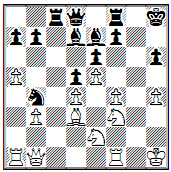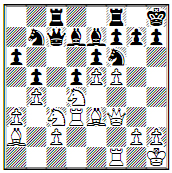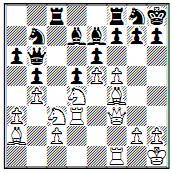 White: GM Alezander Ivanov (2540) White: GM Alezander Ivanov (2540)
Black: GM Varuzhan Akobian (2611)
[C05] French Defense
Saint Louis MO (6), 20.04.2011
The following game was awarded the tournament’s best game prize 1.e4 e6 2.d4 d5 3.Nd2 Nf6 4.e5 Nfd7 5.c3 c5 6.f4 Nc6 7.Ndf3 Qb6 8.a3 Be7 [The more active 8...f6 allows 9.Bd3 and Black can't take the Pawn: 9...cxd4 10.cxd4 Nxd4?? 11.Nxd4 Qxd4 12.Bg6++-] 9.h4 I had reached this position before always choosing 9.b4. Another common move here is 9.Ne2. 9...cxd4 [Black can try the immediate 9...Na5!? 10.b4 (10.dxc5 Bxc5 11.b4 Bf2+ 12.Ke2 Nc4 (12...Bxg1 13.Rxg1 (13.bxa5?? Qf2+ 14.Kd3 Nc5#) 13...Nc4 14.Qd4 unclear) ) 10...cxb4 11.axb4 Nc4=] 10.cxd4 Na5 11.g3N [If 11.Ne2!? then Black can trade Queens by 11...Qb3; Of course, 11.Bd3 loses a Pawn after 11...Nb3 12.Rb1 Nxd4 13.Nxd4 Qxd4] 11...Nb3 [11...Nb8!?] 12.Rb1 Nxc1 [12...Nb8!?] 13.Qxc1 Qd8 I was expecting the more natural looking [13...0-0!? 14.Bd3 Nb8, for example 15.Ne2 Nc6 16.0-0 Bd7 17.b4 Rac8 18.Qe3 a6 with chances for both sides] 14.Bd3 Nb6 15.Ne2 Bd7 16.b3 Rc8 17.Qb2 0-0 18.0-0 Na8 This move looks strange at first, but it's not bad. Black prepares Nc7 and then Bb5. [18...a5!? 19.a4 (19.Rfc1=) 19...Bb4 20.Ne1 f5!? 21.exf6 gxf6 22.f5 exf5 23.Ng2 unclear] 19.Ra1 White is preparing Qb1 and makes sure Pa3 is protected 19...Qb6 20.a4 This stops Bb5, but weakens b4 square 20...Nc7 21.Qb1 Both players saw the following line: [21.a5 Qb4 22.Ne1 Bd8 23.Nc2 Qe7 with unclear play, for example, 24.Ne3!? f5!? (24...Bb5 25.Bxb5 Nxb5 26.f5 Qd7 27.f6 gxf6 28.exf6 Nd6 29.Ng4 Ne4 unclear) ] 21...h6 [21...g6 allows 22.h5] 22.g4 [White doesn't want the quiet equality after, for example, 22.a5 Qb4 23.Ra2 Bb5 24.Kg2=] 22...Na6 Now the play gets sharper 23.g5 Nb4 [23...h5 24.f5 (24.g6 f5 unclear) 24...exf5 25.Nf4 with compensation for material]

24.gxh6 [24.Bh7+?! Kh8 and if 25.gxh6? g6-+; 24.Kh1 h5!?] 24...gxh6 [24...Nxd3 25.hxg7] 25.Kh1 Kh8 26.a5 I decided against the immediate [26.f5 because the Black Queen could use the sixth rank after 26...exf5 (26...Nxd3 27.f6!? Bxf6 28.Qxd3 Bg7 29.Rg1 and if 29...Rg8 30.Ng5!) 27.Bxf5 Bxf5 28.Qxf5 Qe6!?=] 26...Qd8?! It was better to deflect the White Rook from g-file by [26...Qc7 27.Rc1 (I remember calculating the following line 27.f5 Nxd3 28.Qxd3 Qc2! 29.Qe3 Qxf5 30.Qxh6+ Qh7=/+) 27...Qd8]

27.f5 Rg8? It's too dangerous to alow f6. Black had two playable alternatives as the following computer analysis shows: [27...exf5 28.Bxf5 Bxh4 29.Rg1 unclear (29.Bxd7?! Qxd7 30.Nxh4? Qh3+-+; 29.Nf4 Bg5) 29...Rc6 30.Ra4 Bxf5 31.Qxf5 Nc2 32.Ra2 Nb4 (32...Ne3 33.Qf4 Bf2 34.Rg2 Nxg2 35.Kxg2+/=) 33.Ra4=; 27...Nxd3 28.Qxd3 exf5 29.Rg1 This was my idea 29...Qc7!? (29...Be6 30.Nf4 (with compensation for the pawn) 30...Rg8 31.Rxg8+ Qxg8 32.Rg1 Qf8 33.Nh5!? Rc6 34.Nf6 Bxf6 35.exf6 Bc8 36.Qe3 Re6 37.Qf4 Re4 38.Qc7!? Rg4 39.b4!? Rxg1+ 40.Kxg1 Be6 41.Qxb7 Qg8+ 42.Kf1 Qg4 43.Ne5 Qf4+ 44.Kg2=) ] 28.f6+/- Now White is clearly better 28...Bf8 [28...Rg4 29.fxe7 Qxe7 30.h5+-] 29.Bh7! Bb5 Black offered a draw here, which I declined 30.Bxg8 Bd3 31.Qd1?! [31.Qe1! I hesitated between this and the move made in the game, instinctively decided to prevent the fork on c2, not realizing that White would avoid the Be4 pin by 31...Kxg8 32.Qg3+ Kh8 33.Nf4! Bh7 34.h5!?+- preparing Ng6+] 31...Kxg8 32.Rg1+ Kh8 33.Nf4 Be4 The only move. 34.Rg3 Rc3 35.Rc1 Nc2?! The best chance to mess things up was [35...Nd3! 36.Nxd3 Rxd3 37.Qe2 Rxd4 Still White is winning after 38.Qf2 Rd3 39.Qg2+-; If 35...Qc8 then 36.Rxc3 Qxc3 37.Kh2 Qc2+ (37...Qb2+ 38.Rg2 Qc3 39.Ng5 Bxg2 40.Nxf7+ Kh7 41.Ng5+! Kh8 42.Ng6+ Kg8 43.Qg4+-) 38.Qxc2 Nxc2+/-] 36.Kh2 Ba3 37.Ng5! Now White is winning. 37...hxg5 38.Rxc3 Bxc1 39.Qxc1 gxf4 40.Qg1 Black resigned after noticing that 40...Qg8 or 40...Qf8 would be met with 41.Rc8!+- 1-0
GM Alexander Ivanov (2540) FIDE
IM Daniel Naroditsky (2438) FIDE
[B86] Sicilian Defense
Saint Louis MO (3), 17.04.2011
The following is the game between the oldest and the youngest player in the last US Championship. I recently turned 55, my opponent is just 15. 1.e4 c5 2.Nf3 d6 3.d4 cxd4 4.Nxd4 Nf6 5.Nc3 a6 6.Bc4 e6 7.Bb3 Nbd7 8.Bg5 Nc5 9.f4 [Another common move here is 9.Qe2 ] 9...Be7 10.Qf3 Qc7 11.f5 [11.0-0-0 leads to more double edged positions] 11...Bd7 [In a later game Ivanov-Castaneda, Massachusetts Open 2011 Black tried 11...b5?! , but got into trouble after 12.fxe6 fxe6 13.e5! Nxb3?! 14.axb3 dxe5 15.Nxe6+/-] 12.0-0 0-0 13.Kh1 Kh8 There are other options here, but if Black is not planning a capture on b3, 13...Kh8 defends against Nf5 after the exchange on e6 since the Pawn will not be pinned. 14.a3 Qb6 [Again Black doesn't want to trade on b3 14...Nxb3!? 15.cxb3 Rac8 16.Rac1 Qb8=] 15.Rad1 Rac8?! This allows White to keep his light squared Bishop. [15...Nxb3!? 16.cxb3 Rac8 17.b4 Rfe8 about equal according to a computer] 16.Be3 Qc7 [Now 16...Nxb3? runs into 17.Nxe6!+/-] 17.Ba2 b5

18.b4 GM Maurice Ashley commenting the game live in a press room said he was surprised to see this move, but the computer agrees with my choice. From now on White stands better. 18...Nb7 19.Rd3 [19.Bd2 Nd8 20.g4 Qb6 (20...d5?! 21.exd5 Nxd5 22.Nxd5 exd5 23.g5 with an attack) 21.Nde2 exf5 22.gxf5 Nc6 unclear] 19...d5? A mistake after which White's advantage increases. Black had to play [19...Nd8 20.fxe6!? fxe6 21.Qe2+/=] 20.e5+/-

Ng8 [According to a computer the alternatives are no good as well: 20...Ne4 21.Nxe4 dxe4 22.Qxe4 exf5 23.Nxf5 Bxf5 24.Qxf5 Qxc2 25.Bb1+/- g6 26.Bxc2!? gxf5 27.Bb3+/-; 20...Qxe5 21.Bf4 Qe4 22.Nxe4 dxe4 23.Qe2 exd3 24.Qxd3 exf5 25.Nxf5 Bxf5 26.Qxf5 Nd6 (26...Rcd8 27.c4+-) 27.Bxd6 Bxd6 28.Bxf7! Rcd8 29.Qe6 Rd7 30.Bh5+-] 21.Bf4 Qb6

22.Nde2 A 'human' move. 'Houdini' shows a more direct win after [22.f6!? gxf6 23.Qh5 Rxc3 24.Rxc3 Qxd4 25.Rg3! (25.Rh3? Qe4 unclear) 25...Qe4 26.exf6 Bxf6 27.Bh6+- To see this far was beyond my capabilities.] 22...Bc6 [22...d4 23.Nxd4 Rxc3 24.Rxc3 Qxd4 25.Rd3 Qb2 26.Rxd7+- ; Black's best chance to complicate matters was the obvious 22...f6 23.Qh3!? (23.fxe6 Bxe6 24.Nxd5 Bxd5 25.Rxd5 fxe5 26.Rxe5 Bd6 27.Re6+/-; 23.Bxd5!? exd5 24.Nxd5 Qd8 25.exf6 Nxf6 26.Nxf6 Bxf6 27.Rfd1!+/- Bc6 28.Rxd8 Bxf3 29.Rxf8+ Rxf8 30.gxf3+/-) 23...Nd8 24.Be3 Qb8 25.Nf4 Be8 26.Nxe6 Nxe6 27.Nxd5 Qxe5 28.fxe6+-] 23.f6 Nxf6 [23...gxf6 24.Qh5+-] 24.exf6 Bxf6 25.Qh5+- g6 26.Be5! Now it's over. 26...Bxe5 [The line 26...gxh5 27.Bxf6+ Kg8 28.Rg3# is not hard to find even for a human player.] 27.Qxe5+ Kg8 28.Nd4 Bd7 29.Bxd5 [29.Nf5 f6 30.Nxd5 exd5 31.Qxd5+ Kh8 32.Qxd7 Rc7 33.Qd4! Qxd4 34.Nxd4+-] 29...Rxc3 30.Rxc3 exd5 31.Qxd5 Nd6 32.Nc6 Re8 33.Qxd6 Qf2 34.Qd1 1-0 |